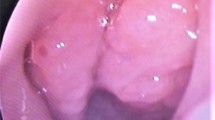Abstract
To establish an association between adenoid hypertrophy and hearing loss and its impact on speech and language in pediatric age group. A prospective case control study done in a tertiary hospital in South India. Twenty children with hearing loss were recruited in the study group and twenty-four children as controls. These groups underwent at detailed otorhinolaryngologic examination, hearing and speech evaluation. The size of the adenoids was graded endoscopically. Findings between the two groups were compared and analysed. Our study found statistically significant association between adenoid hypertrophy with choanal obstruction and abutment of eustachian tube opening seen on endoscopy with hearing loss (p = 0.025). The children with hearing loss also had speech and language delay (p = 0.004). Children with enlarged adenoids obstructing the > 50% of the choanae or abutting the eustachian tube opening are more likely to have hearing loss and may develop speech and language delay. The ACE endoscopic adenoid grading system is consistent and reliable in evaluation of adenoids.

Similar content being viewed by others
References
Jacob A, Rupa V, Job A, Joseph A (1997) Hearing impairment and otitis media in a rural primary school in South India. Int J Pediatr Otorhinolaryngol 39(2):133–138
Haapaniemi JJ (2007) Adenoids in school-aged children. J Laryngol Otol 109(03):196–202
Sanli A, Tasdemir O, Eken M, Celebi O, Yilmaz SH (2011) Prevalence of otitis media with effusion among primary school age-children and etiopathogenic examination. Indian J Otolaryngol Head Neck Surg. https://doi.org/10.1007/s12070-011-0336-1
Verhoeff M, van der Veen EL, Rovers MM, Sanders EAM, Schilder AGM (2006) Chronic suppurative otitis media: a review. Int J Pediatr Otorhinolaryngol 70(1):1–12
Keogh T, Kei J, Driscoll C, Khan A (2010) Children with minimal conductive hearing impairment: speech comprehension in noise. Audiol Neurotol 15(1):27–35
Rapin I (1979) Conductive hearing loss effects on children’s language and scholastic skills: a review of the literature. Ann Otol Rhinol Laryngol 88(5 Pt 2 Suppl 60):3–12
Chadha SK, Sayal A, Malhotra V, Agarwal AK (2013) Prevalence of preventable ear disorders in over 15,000 schoolchildren in northern India. J Laryngol Otol 127(01):28–32
Varghese AM, Naina P, Cheng AT, Asif SK, Kurien M (2016) ACE grading: a proposed endoscopic grading system for adenoids and its clinical correlation. Int J Pediatr Otorhinolaryngol 83:155–159
Bluestone CD (1998) Epidemiology and pathogenesis of chronic suppurative otitis media: implications for prevention and treatment. Int J Pediatr Otorhinolaryngol 42(3):207–223
Bluestone CD, Klein JO (1995) Clinical practice guideline on otitis media with effusion in young children: strengths and weaknesses. Otolaryngol Neck Surg 112(4):507–511
Brodsky L (1989) Modern assessment of tonsils and adenoids. Pediatr Clin North Am 36:1551–1569
Abreu RR, Rocha RL, Lamounier JA, Guerra ÂFM (2008) Etiology, clinical manifestations and concurrent findings in mouth-breathing children. J Pediatr (Rio J) 84(6):529–535
Kindermann CA, Roithmann R, Neto JFL (2008) Sensitivity and specificity of nasal flexible fiberoptic endoscopy in the diagnosis of adenoid hypertrophy in children. Int J Pediatr Otorhinolaryngol 72(1):63–67
Wormald PJ, Prescott CA (1992) Adenoids: comparison of radiological assessment methods with clinical and endoscopic findings. J Laryngol Otol 106(4):342–344
Acharya K, Bhusal CL, Guragain RP (2010) Endoscopic grading of adenoid in otitis media with effusion. JNMA J Nepal Med Assoc 49(177):47
Saedi B, Sadeghi M, Mojtahed M, Mahboubi H (2011) Diagnostic efficacy of different methods in the assessment of adenoid hypertrophy. Am J Otolaryngol 32(2):147–151
Parikh SR, Coronel M, Lee JJ, Brown SM (2006) Validation of a new grading system for endoscopic examination of adenoid hypertrophy. Otolaryngol Head Neck Surg 135(5):684–687
Zumach A, Chenault MN, Anteunis LJC, Gerrits E (2011) Speech perception after early-life otitis media with fluctuating hearing loss. Audiol Neurotol 16(5):304–314
Maw R, Wilks J, Harvey I, Peters TJ, Golding J (1999) Early surgery compared with watchful waiting for glue ear and effect on language development in preschool children: a randomised trial. Lancet Lond Engl 353(9157):960–963
Roberts J, Rosenfeld RM, Zeisel SA (2004) Otitis media and speech and language. Pediatrics 113(3):238–248
Author information
Authors and Affiliations
Corresponding author
Rights and permissions
About this article
Cite this article
Syed, K.A., Naina, P., Sebastian, S. et al. A Case–Control Study on the Association Between Endoscopic ACE Grade of Adenoid Hypertrophy and Hearing Loss in Children and Its Impact on Speech and Language Development. Indian J Otolaryngol Head Neck Surg 71, 150–154 (2019). https://doi.org/10.1007/s12070-018-1506-1
Received:
Accepted:
Published:
Issue Date:
DOI: https://doi.org/10.1007/s12070-018-1506-1




